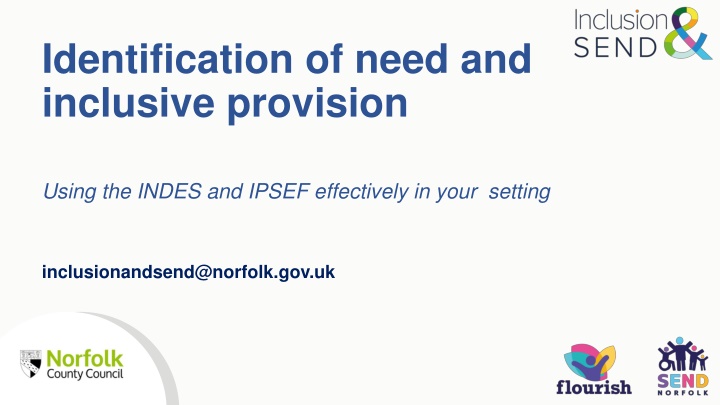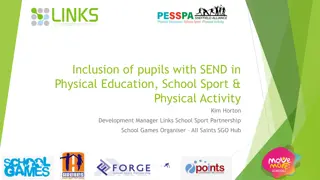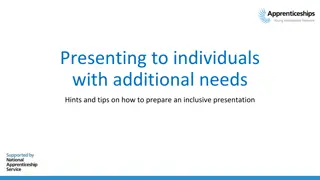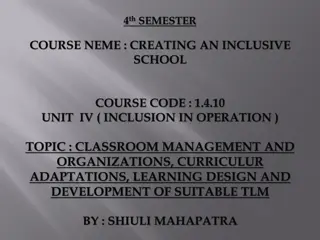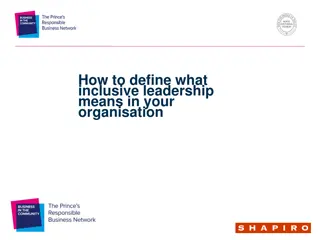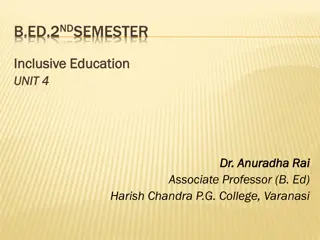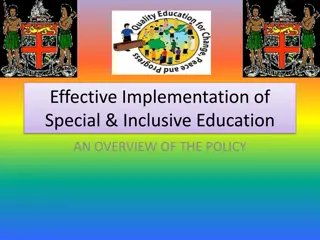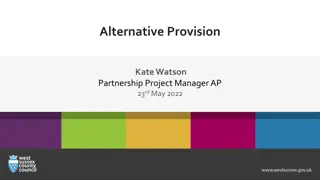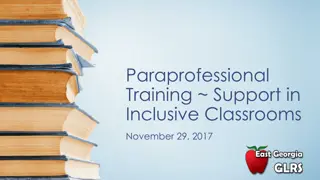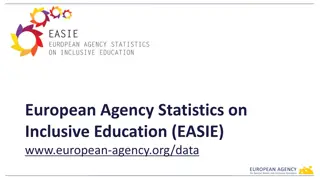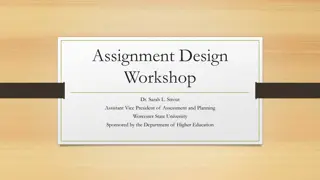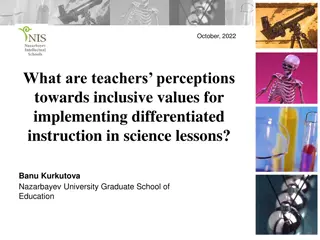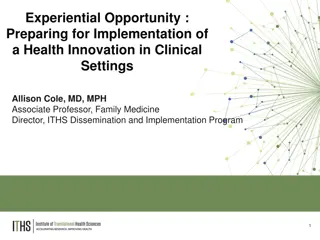Effective Implementation of INDES and IPSEF for Inclusive Provision
Enhance your understanding of the INDES and IPSEF tools for inclusive provision in educational settings. This resource provides guidance on identifying needs, implementing the tools effectively, and aligning provision with individual requirements. Explore the benefits of using these tools, ensuring accurate information sharing, establishing shared understanding, and supporting inclusive education. Contact the Inclusion and SEND team for further assistance.
Download Presentation

Please find below an Image/Link to download the presentation.
The content on the website is provided AS IS for your information and personal use only. It may not be sold, licensed, or shared on other websites without obtaining consent from the author.If you encounter any issues during the download, it is possible that the publisher has removed the file from their server.
You are allowed to download the files provided on this website for personal or commercial use, subject to the condition that they are used lawfully. All files are the property of their respective owners.
The content on the website is provided AS IS for your information and personal use only. It may not be sold, licensed, or shared on other websites without obtaining consent from the author.
E N D
Presentation Transcript
Identification of need and inclusive provision Using the INDES and IPSEF effectively in your setting inclusionandsend@norfolk.gov.uk
Support for facilitators This PowerPoint has been created to support settings to introduce and implement the INDES with their staff. Each setting is unique. Please adapt this presentation to suit your individual setting and approach. (Remember to modify the contents page accordingly!) The appendix (slide 26) contains guidance and examples to support facilitation. These slides are not intended to be used during presentation to staff. Further support and advice is available by contacting the Inclusion and SEND team: INDES and IPSEF support indesipsefsupport@norfolk.gov.uk General enquiries - inclusionandsend@norfolk.gov.uk SEND funding case-specific enquiries element3funding@norfolk.gov.uk
Session outline Overview What are the INDES and IPSEF? Benefits of use Overview: INDES, IPSEF and PEaSS Reflection on current processes INDES (Identification of Need in Educational Setting) INDES Overview INDES Shared example INDES data collection tool Submitting the INDES Ensuring Provision meets need: IPSEF and PEaSS IPSEF (Inclusion and provision self-evaluation framework) PEaSS PEaSS Shared Example
What are the INDES, IPSEF and PEaSS? The Identification of Needs Descriptors in Educational Settings (INDES) and the Inclusion and Provision Self Evaluation framework (IPSEF) are two tools which provide a commonality of language and shared understanding of the presentation of special educational needs in education settings and establish a context for making provision inclusive. These tools dovetail with Norfolk s Provision Expected at SEN Support (PEaSS) suite of resources: Provision Expected at SEN Support (PEaSS) guidance - Norfolk County Council
Benefits of use Commonality of Language Describe provision and need consistently across settings Supports accurate information sharing upon transition Identify the full scope of a CYP s profile of need Shared understanding Using the INDES helps a setting identify patterns of need and where provision is needed Using IPSEF supports a whole setting approach to inclusive education Establishing a context for making provision inclusive Use alongside PEaSS suite of resources Resources and signposting to support needs identified using the INDES
Overview: INDES, IPSEF and PEaSS Individual pupil needs INDES Identification of pupil specific needs. Completing for every CYP supports identification of needs across cohorts/whole school to inform provision and CPD Identification of Needs Descriptors in Educational Settings IPSEF Whole school provision evaluation Inclusion and Provision Self-Evaluation Framework Whole school self-evaluation of inclusive practice and provision Setting and individual provision PEaSS Strategies and resources to support individuals at a whole school, classroom and SENDCo specific level Provision Expected at SEN Support
Reflection on current processes How do we currently identify need? Do we have a shared language and consistent process to identify need and plan provision?
INDES (Identification of Needs Descriptors in Educational Settings) The INDES are a set of descriptors used to identify an individual CYP s profile of need. They are divided into seven areas: o Speech, Language and Communication Needs o Deafness o Social Communication and Interaction o Visual Impairment o Learning and Cognition Difficulties o Physical Disability o Social, Emotional and Mental Health Each area has 7 levels which indicate increasing occurrence and/or complexity of need. 1. 2. Complete INDES webform INDES descriptors table Handout
INDES and the four broad areas Learning and Cognition Difficulties Social, Speech and Language Emotional and Mental Health Deafness Social Visual Impairment Communication and Interaction INDES Areas of Need Physical Disability Four Broad Areas of Need Communication and Interaction Cognition and Learning Social, Emotional and Mental Health Physical and Sensory
Shared example Polly is 9 years old. Polly s speech and language skills are delayed by 12 months. She has difficulties with attention and listening and understanding (especially inference). Polly finds dealing with change difficult. She can become distressed when changing from one activity to the next. Polly is very sensitive to noise and certain textures. She finds busy spaces overwhelming, including assemblies and the canteen. She has ear defenders. Polly prefers to play on her own at playtime playing fairies which is based on a tv show she likes. With adult support, she can play alongside others if the rules of the game are clear. Polly is a fluent reader and imaginative writer. She has good mental maths skills. Often, she struggles to start independent work as she misses verbal instructions. When this happens, she can become very anxious. Polly often needs support to organise her belongings and frequently forgets her reading book/homework. 1. Complete INDES webform 2. INDES descriptors table 3. INDES guide to complete SLCN section 4. Shared example - Polly Handout
Shared example Which statements did you select to describe Polly s needs? 5. Completed INDES descriptors table Shared Example Polly Handout
Shared example Jake is 14 years old Jake enjoys PE but finds most other areas of learning difficult, especially reading and writing. Jake finds it difficult to remember verbal information and instructions. He often finds it difficult to retain information given by the teacher and becomes frustrated if he does not know what to do. Jake can become heightened very quickly, especially in lessons he finds difficult. During these times, he often becomes angry with adults or leaves the classroom and walks around the school site. Jake is friends with CYP in the year below him. He has frequent verbal and physical altercations with peers. It is reported that he instigates these. With known adults on a 1:1 basis, Jake can start to talk about how he is feeling and what he finds hard, although he finds this very difficult. He voices that he thinks teachers hate him, no one helps him, the work is too hard and that everyone else can do it apart from him. Jake has adult support for English and maths lessons. He accesses the school hub where he checks in with a member of pastoral staff each morning. He can use this as a regulation space when heightened. 1. Complete INDES webform 2. INDES descriptors table 3. INDES guide to complete SLCN section 6. Shared example - Jake Handout
Shared example Which statements did you select to describe Jake s needs? 7. Completed INDES descriptors table Shared Example Jake Handout
INDES data collation tool When collating INDES submissions from across a setting, the INDES data collation tool can be used to collate all the information needed to provide a profile of need for a cohort of children and young people. This may be useful for secondary settings where multiple staff may be contributing. The data collation tool can be used to complete individual INDES webforms. Examples of how a settings used the data collation tool are included in the INDES implementation guide case studies. INDES data collection tool
Submitting the INDES Click on the link to the INDES webform on the Norfolk Schools website: Identification of needs descriptors in educational settings (INDES) - Schools (norfolk.gov.uk) Ensure you have the necessary information to hand as you will not be able to save your progress once you have started to fill in the form. - - - - CYP s first and last names, CYP s date of birth Unique Pupil Number/Early Years number Supporting evidence ready to upload (SEN Support plan, health care plan and/or EHC plan see below for further guidance on uploading evidence) SENDCo full name and email address Head/Principal full name and email address - - Detailed guidance on submitting the INDES is available in the INDES implementation guide.
Submitting the INDES Individual INDES Summary emailed to setting following submission Summary of statements ticked Overall "iLevels" for each section: 0-7 No number = 0
Implementing the INDES Key Question Our setting s approach Key dates For which CYP will we complete an INDES? Who will complete the INDES? Who will submit the INDES? How will we use the INDES to review and plan provision? How often will we review the INDES? How will we moderate the INDES? (Internally and externally?)
Ensuring provision meets need PEaSS IPSEF (Provision Expected at SEN Support) (Inclusion and Provision Self-Evaluation Framework) What special educational need (SEN) Support A whole school framework to evaluate provision to support inclusive practice. we expect places of learning to provide for children and young people with special educational needs and disabilities (SEND) What parent carers can expect their child s places of learning to provide
IPSEF(Inclusion and Provision Self-Evaluation Framework) Culture and Ethos INEFFECTIVE - The setting s curriculum does not take into consideration all learners and their needs. Leaders are unsure about the quality of teaching overall and do not support teachers in planning inclusive lessons TAKING ACTION - The setting s curriculum takes into consideration most learners and their needs. Leaders have monitoring systems in place, but these do not inform CPD for teachers needing support in planning for all EFFECTIVE - The setting s curriculum is good and developing towards outstanding in its intent. Leaders have monitoring systems in place that support teachers in their planning, but this is still in its developmental stage LEADING - The setting s curriculum is outstanding and designed to meet the needs of all learners. Leaders have a clear process for monitoring its implementation and supporting teachers to confidently plan highly inclusive lessons which enable all pupils to progress o 1.04 : Leaders place high value on the quality of the setting s curriculum in its intent to provide a quality education for all pupils and in its implementation, by teachers who are confident to plan to meet the needs of all CYPs o o o Example of IPSEF statements and judgements: Culture and Ethos
IPSEF(Inclusion and Provision Self-Evaluation Framework) INEFFECTIVE - Teachers and support staff are not able to identify learners with SLCN. Staff have had little or no training around SLCN needs TAKING ACTION - Teachers and support staff can identify learners with SLCN but are not confident with strategies or interventions to help learners overcome these barriers. Staff have been trained and are broadly confident in identifying needs EFFECTIVE - Teachers and support staff can identify learners with SLCN and are confident in identifying strategies and interventions to help learners overcome these barriers. Staff are trained and are confident in identifying needs and knowing the next steps LEADING - Teachers and support staff can identify learners with SLCN and use a wide range of strategies and interventions to help learners overcome these barriers. Staff are trained and confident in identifying need and take action swiftly to remove barriers Provision o 2.02 The setting identifies learners with speech, language and communication (SLCN) needs and uses appropriate strategies and interventions to help learners overcome these barriers o o o Example of IPSEF statements and judgements: Provision
IPSEF(Inclusion and Provision Self-Evaluation Framework) Independence INEFFECTIVE - No additional support is provided for transition at key points. Communication between settings is minimal TAKING ACTION - Some additional support is provided for transition at key points e.g. extra visits. Communication between settings takes place. Those CYPs with the highest level of need are confident about moving to their new setting but others may not feel as confident EFFECTIVE - A range of additional support is provided at key points e.g. extra visits; photo books. Communication between settings is effective and most CYPs are confident about moving to their new setting LEADING - A wide range of additional transition support is available at key points e.g. extra visits; photobooks; wider liaison between providers. Communication between settings is highly effective. All CYPs are confident about moving to their new setting o o 6.03 : Transition between stages of education is effective o o Example of IPSEF statements and judgements: Independence
PEaSS (Provision Expected at SEN Support) Posters contain hyperlinks to strategies to try and key sources of guidance or resources 8. 9. Provision Expected at SEN Support PEaSS posters Handout
Shared example Choose one section of the PEaSS to focus on. What provision does Polly require to meet her needs? What high quality teaching strategies would be beneficial for her? How might you adapt the curriculum to meet her needs? 4. Shared example - Polly 8. Provision Expected at SEN Support 9. PEaSS posters Handout
Shared example Choose one section of the PEaSS to focus on. What provision does Jake require to meet his needs? What high quality teaching strategies would be beneficial for him? How might you adapt the curriculum to meet his needs? 6. Shared example - Jake 8. Provision Expected at SEN Support full version 9. PEaSS posters Handout
Appendices Example slides to support facilitators Slide 7: Slide 11: Slide 13: Slide 17: Slide 24: Slide 25: Reflection on current processes INDES Shared Example discussion: Polly INDES Shared Example discussion: Jake Implementing the INDES PEaSS Shared Example: Polly PEaSS Shared Example: Jake
Reflection on current processes How do we currently identify need? Do we have a shared language and consistent process to identify need and plan provision? Key Questions to consider which may aid in facilitating discussion: How does our setting s/multi-academy trust s policy outline how we identify need? Does our SEN Information Report outline how we identify need? Is this communicated clearly to parents/community? What does the APDR cycle look like in our setting? Who is involved in re-assessing need and reviewing provision regularly? Is it effective? What regular training is in place for staff? Do SLT and the SENDCO model and embed consistent, positive language when describing SEND? How is negative/offensive language challenged? (Even if offense is not intended.)
Shared example Draw out key words and phrases with staff Polly is 9 years old. (examples in bold.) What does this tell us about Polly s needs? Polly s speech and language skills are delayed by 12 months. She has difficulties with attention and listening and understanding (especially inference). Polly finds dealing with change difficult. She can become distressed when changing from one activity to the next. Polly is very sensitive to noise and certain textures. She finds busy spaces overwhelming, including assemblies and the canteen. She has ear defenders. Polly prefers to play on her own at playtime playing fairies which is based on a tv show she likes. With adult support, she can play alongside others if the rules of the game are clear. Polly is a fluent reader and vivid writer. She has good mental maths skills. Often, she struggles to start independent work as she misses verbal instructions. When this happens, she can become very anxious. Polly often needs support to organise her belongings and frequently forgets her reading book/homework. See CYP Case Study Primary (INDES Implementation Guide p.12) for breakdown of how this description of need relates to INDES statements. (you could also print this and use as an example with staff should you wish.) Select only the statement which apply to the CYP. Some statements are similar, building in complexity of need from 1-7. Only select the highest applicable statement in this case. Which statements did you select to describe Polly s needs?
Shared example Draw out key words and phrases with Jake is 14 years old staff (examples in bold.) What does this Jake enjoys PE but finds most other areas of learning difficult, especially reading and writing. Jake finds it difficult to remember verbal information and instructions. He often finds it difficult to retain information given by the teacher and becomes frustrated if he does not know what to do. Jake can become heightened very quickly, especially in lessons he finds difficult. During these times, he often becomes angry with adults or leaves the classroom and walks around the school site. Jake is friends with CYP in the year below him. He has frequent verbal and physical altercations with peers. It is reported that he instigates these. With known adults on a 1:1 basis, Jake can start to talk about how he is feeling and what he finds hard, although he finds this very difficult. He voices that he thinks teachers hate him, no one helps him, the work is too hard and that everyone else can do it apart from him. Jake has adult support for English and maths lessons. He accesses the school hub where he checks in with a member of pastoral staff each morning. He can use this as a regulation space when heightened. tell us about Jake s needs? See CYP Case Study Secondary (INDES Implementation Guide p.17) for breakdown of how this description of need relates to INDES statements. (you could also print this and use as an example with staff should you wish.) Select only the statement which apply to the CYP. Some statements are similar, building in complexity of need from 1-7. Only select the highest applicable statement in this case. Which statements did you select to describe Jake s needs?
Implementing the INDES example 1 Key Question Our setting s approach Key dates For which CYP will we complete an INDES? We will complete an INDES for all of the CYP with SEND. We will begin by completing INDES for high needs pupils (those with EHCPs and higher levels of SEN). A list of pupils has been provided for each class. SM:INDES introduction Oct 22. SM: Complete INDES for HN pupils Nov 22. SM: Remaining INDES: Jan 22 Who will complete the INDES? Teachers will complete the INDES with support from SENDCO and SLT. Staff meeting dates above. Who will submit the INDES? The SENDCo will work in a group with teaching assistants to submit the INDES. They will be given time out of class to do this. (This could be during assembly/PE lesson) 2 weeks after each staff meeting. How will we use the INDES to review and plan provision? The INDES will be part of the ADPR cycle and will be referred to when reviewing and updating pupil passports and individual learning plans. For each statement ticked we will consider what provision is required using the PEaSS document and discussion with SENDCo. Termly How often will we review the INDES? The INDES will be reviewed termly as part of our APDR cycle. They do not have to filled in again/resubmitted, but teachers will check to ensure that the needs identified are still accurate. Termly How will we moderate the INDES? (Internally and externally?) SENDCO will moderate a sample of INDES each term to ensure accuracy and that they do not need updating to reflect changes in need. We will work with a local cluster of schools to carry out external moderation of the INDES. Termly See also Setting Case Study Primary (INDES Implementation Guide p.21) for further guidance on implementing the INDES
Implementing the INDES example 2 Key Question Our setting s approach Key dates For which CYP will we complete an INDES? We will complete an INDES for all of the CYP with SEND. We will begin by completing INDES for high needs pupils (those with EHCPs and higher levels of SEN). By Oct half term. 2nd half Autumn term. Complete by Feb half term. Who will complete the INDES? Heads of year will oversee completion of the INDES for those children in their year group (with support from SENDCO and SLT.) HOYs will introduce the INDES during team meetings and complete two example INDES together. Staff will use the INDES data collation tool. Who will submit the INDES? Admin staff will submit the INDES using the INDES data collation tool for reference. HNCYP by 18.11.22 All CYP by 10.03.22 How will we use the INDES to review and plan provision? The INDES will be part of the ADPR cycle and will be referred to when reviewing and updating pupil passports and individual learning plans. For each statement ticked we will consider what provision is required using the PEaSS document. The SEND team will oversee this initially. Year group teams will have greater input over time. Termly. Year group teams to review Learning plans alongside PEaSS Summer term 22 How often will we review the INDES? The INDES will be reviewed termly as part of our APDR cycle. They do not have to filled in again/resubmitted, but the SEND team will check to ensure that the needs identified are still accurate. Termly How will we moderate the INDES? (Internally and externally?) SEND team will moderate a sample of INDES each term to ensure accuracy and that they do not need updating to reflect changes in need. Termly See also Setting Case Study Secondary (INDES Implementation Guide p.24) for further guidance on implementing the INDES
Shared example Choose one section of the PEaSS to focus on. What provision does Polly require to meet her needs? What high quality teaching strategies would be beneficial for her? How might you adapt the curriculum to meet her needs? Communication and Interaction: Speech Language and Communication Provision Keep verbal instructions simple and use them in the order you want things to be carried out. Ask instructions to be repeated back. Use learner s name before asking a question. Personalised/small group learning/modelling to target inference skills. SCLN screening/assessment to ensure full scope of SCLN are understood. HQT and curriculum adaptations SENDCo actions 4. Shared example - Polly 8. Provision Expected at SEN Support full version 9. PEaSS posters Handout
Shared example Choose one section of the PEaSS to focus on. What provision does Polly require to meet her needs? What high quality teaching strategies would be beneficial for her? How might you adapt the curriculum to meet her needs? Communication and Interaction: Social Communication Difficulties/Autistic Spectrum Provision Ensure effective transitions are in place at every stage and particularly at phase transfer. Incorporate time for sensory circuits Be aware of sensory issues (smell, clothing, noise, touch) and consider reasonable adjustments such as ear defenders Be aware that the learner may not understand certain types of humour and may take things literally. Deliver interventions to develop social communication skills through small group work, negotiating activities, turn-taking/sharing, role-play/social stories as appropriate. Monitor the impact of any interventions, for example by using the AET progression tools HQT and curriculum adaptations SENDCo actions 4. Shared example - Polly 8. Provision Expected at SEN Support full version 9. PEaSS posters Handout
Shared example Choose one section of the PEaSS to focus on. What provision does Jake require to meet his needs? What high quality teaching strategies would be beneficial for him? How might you adapt the curriculum to meet his needs? Communication and Interaction: Speech Language and Communication Provision Keep instructions short and give time for understanding. Provide visual prompts as a reminder. Enable recording alternatives to writing such as Clicker, posters, pictures, diagrams, mind-maps, sorting statements. Break down learning into chunks. Check understanding regularly. Start the next session with recap. HQT and curriculum adaptations SENDCo actions Ensure that Jake s cognition difficulties are well understood. Consider assessment by an Educational Psychologist or Specialist Learning Support Teacher. 6. Shared example - Jake 8. Provision Expected at SEN Support full version 9. PEaSS posters Handout
